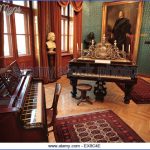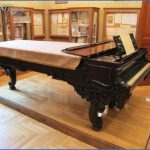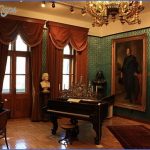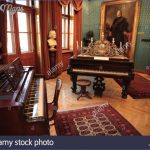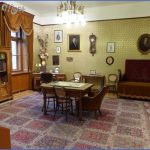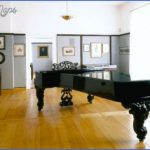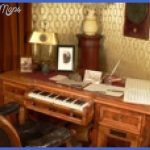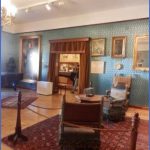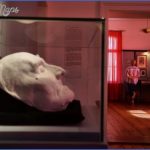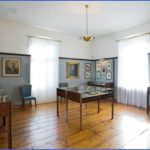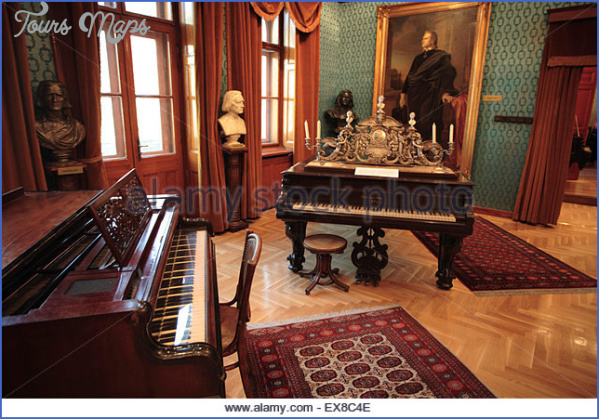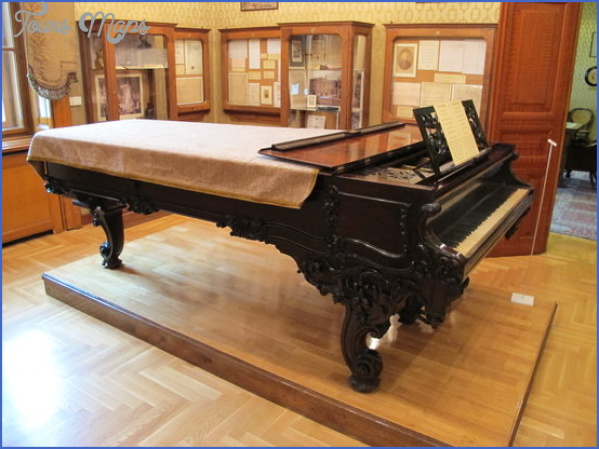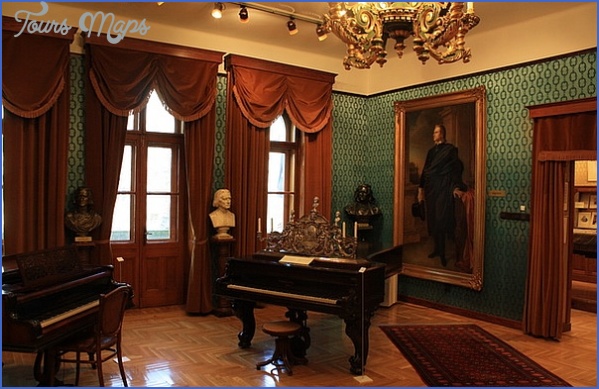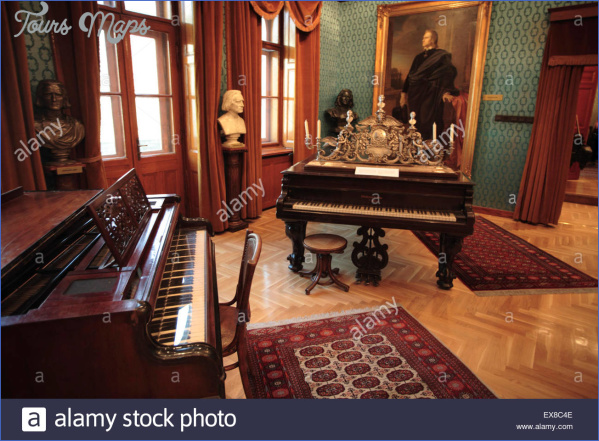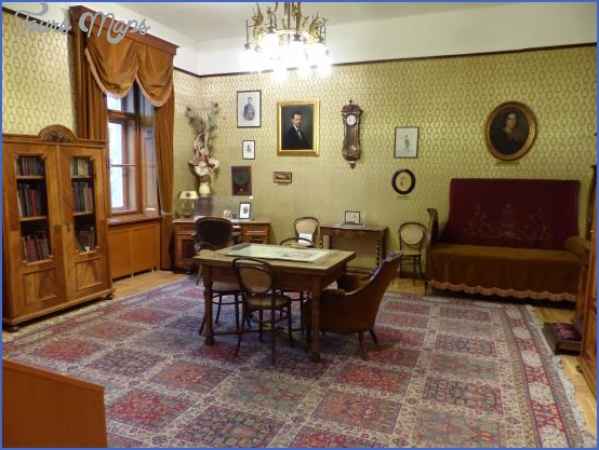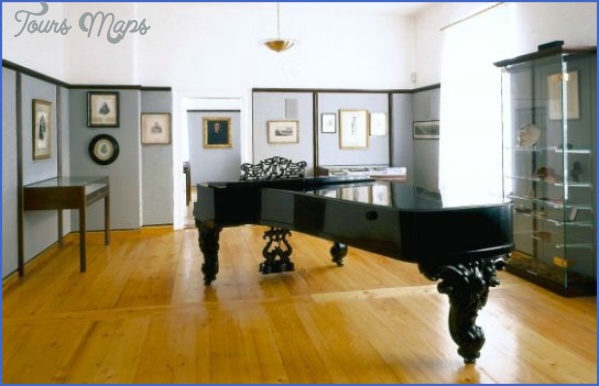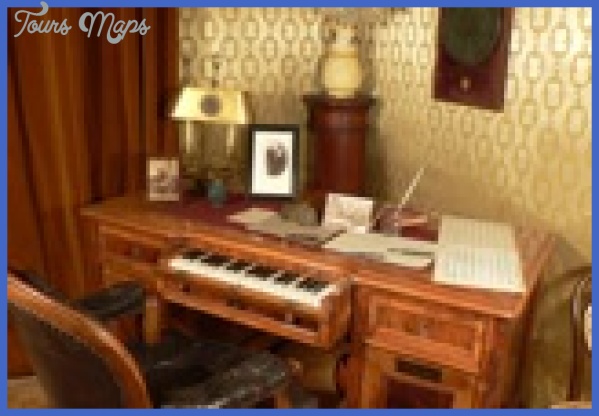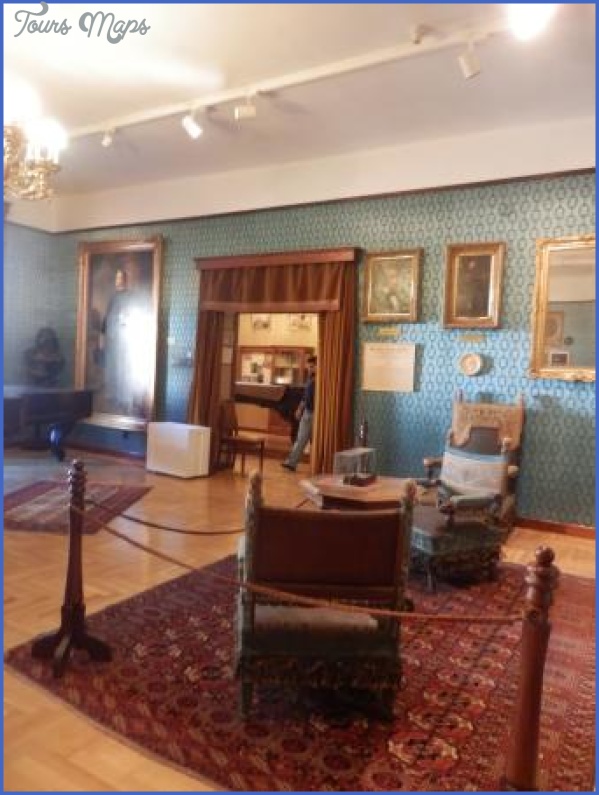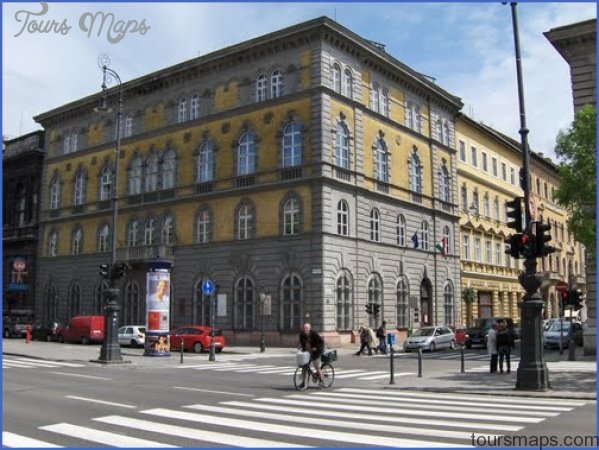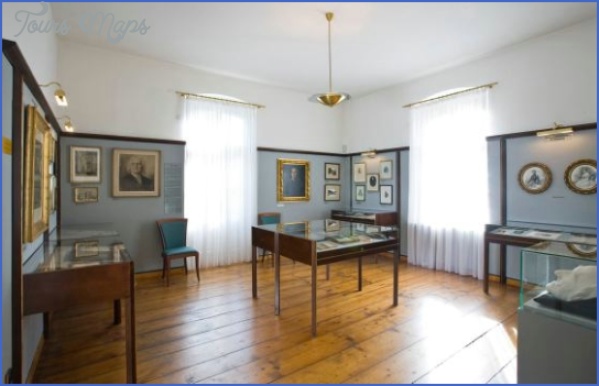LISZT MUSEUM
Franz Liszt was one of the great travellers among composers. Were his overnight resting-places across Europe marked by plaques, like the one-night stands ascribed (apocryphally or otherwise) to Queen Elizabeth I or George Washington, those two would seem positively provincial by comparison. In Liszt’s case, the habits he formed during his early career as a concert pianist dictated the peripatetic life-style he maintained right up to the time of his death. He did have some settled spells, in Vienna (1821-3), in Paris (1823-7) and, when his life as a virtuoso pianist was behind him, in Weimar (1848-61) and then Rome (1861-9); but for his last 17 years he tended to move with the seasons, with residences in Weimar (summer), Rome (autumn and winter), Budapest (winter and spring), and at the end of his life Bayreuth (during the festival).
The oldest of the buildings commemorating him, however, is at his birthplace, the rural village of Raiding, which he had left at the age of 11 when he went to study in Vienna with Salieri and Czerny. His father was a prosperous dairy farmer and an administrator for the Esterhazy estates. Raiding was then in Hungary (it was called Doborjan), and Liszt always regarded himself as a Hungarian, although he did not speak the language; since 1919 the village has been Austrian, in
Rights were not granted to include these illustrations in electronic media. Please refer to print publication Liszt’s birthplace (lithograph by Stadler after a drawing by Grunes) the Burgenland, where it lies some 40 km south of Eisenstadt. Liszt visited his birthplace in 1840 and gave money for a new organ; he was back in 1846, and in 1848, when he tried to buy the family dairy building, then in 1872 and finally in 1881, when at a ceremony in his presence shortly before his 70th birthday it was dedicated as a memorial to him and a plaque was erected (with aggressively controversial wording: ‘Hier wurde Franz Liszt am 22. Oktober 1811 geboren. Diese Gedenktafel weihte dem deutschen Meister das deutsche Volk’: ‘Here Franz Liszt was born on 22 October 1811. This memorial plaque is dedicated by the German people to the German master’). It was opened as a museum in 1911, to mark Liszt’s centenary, and reopened after World War II in 1951; the cottage was still the property of the Esterhazy family until 1971, when Dr Paul Esterhazy presented it to the Raiding community, and later in the 1970s it passed into the care of the Burgenlandisches Landesmuseum. But by then the building, which dates back to the 16th century, had considerably changed. In Liszt’s time it was T-shaped, with stabling and other farm accommodation, but the horizontal wing has been demolished and the vertical somewhat rebuilt.
There are now essentially three rooms. To the right as you enter is the room in which, it is claimed, he was born; the display is concerned primarily with Liszt’s family and friends, with a family tree and a map of his travels. The main, central room is large enough to accommodate small-scale recitals; the room to the left contains the small organ that Liszt helped to buy for Raiding in 1840 and there is a collection of photographs of him from the 1870s and 80s. Liszt postage stamps, medallions and other commemorative items are displayed in the entrance hall.
LISZT MUSEUM Photo Gallery
In 1842, Liszt accepted the post of Kapellmeister at the Weimar court. On his very first visit he was taken with Weimar and wrote to Berlioz that one could breathe in the sense of its being a cultivated and artistic city. It was another six years before he gave up his travelling existence and took up residence – and then in awkward circumstances. He maintained a postal address at the Hotel Erbprinz but lived, with Princess Carolyne Sayn-Wittgenstein, in a 30-room villa known as the Altenburg, perched on the hill of that name above the city; there he installed his furniture, books, paintings and instruments, including a square piano that allegedly had belonged to Mozart and Beethoven’s Broadwood. During his 12-year tenure, Weimar was visited by an unprecedented procession of the European musical elite. Despite the significance of the Altenburg, it has never been a Liszt museum. Liszt’s later Weimar home, however, the Hofgartnerei, became one shortly after his death. Originally the court gardener’s house, and for a time the palace nursery, the building in which he had a flat is in the Marienstrafie, at the entrance to Ilm Park. (Immediately across the street, in what had been the house of Johann Nepomuk Hummel, lived that composer’s widow and grand- Rights were not granted to include these illustrations in electronic media. Please refer to print publication Liszt’s music room, Weimar Hofgartnerei daughters; but no meeting is recorded -not surprisingly, for Hummel’s widow held that Liszt had ‘destroyed the true art of piano playing’.) Liszt’s patron, Grand Duke Carl Alexander, put the flat at Liszt’s disposal from 1869 and the Grand Duchess herself supervised its decoration. Liszt used it for 17 years. It was in his music room on the first floor that he held his famous master-classes, attended by a succession of young pianists including Moriz Rosenthal, Alexander Siloti, Amy Fay and Sophie Menter, on three afternoons a week, from 4 o’clock for two hours. When Liszt died, in 1886, the Grand Duke ordered the flat to be preserved and the following year he authorized its opening as a museum. To ensure the safe keeping of the large quantity of manuscripts, correspondence, documents and personal possessions, Carl Alexander established the Liszt Foundation, now based in the Goethe and Schiller Archive in Weimar. The house itself suffered damage in World War II but was then restored; the music room and study remain much as Liszt left them, while the dining-room and bedroom (the small cot bed conveying an unexpectedly Spartan impression) have been reconstructed. His Bechstein concert grand is there, along with an upright, and there are displays of some of the gifts showered on him by European royalty as well as civic honours and citations, facsimiles of manuscripts and letters, and an amusing collection of ornamental walking-sticks.
Liszt did not live elaborately: in a letter of 1871, when a flat was being prepared for him in Budapest, he specified that ‘the style of my abode must be simple and comfortable, with no trappings’; he required only a large desk and a couple of Bosendorfers. That flat was in Budapest; ten years later he moved to another, on the first floor of the recently established Academy of Music in Vorosmarty utca. This one had taken two years in preparation as the furnishings were specially designed and donated by his admirers in
The former Academy of Music in Budapest the Hungarian capital; a service flat, it was given to him in return for the teaching he offered there – and his performances, presumably, which were made particularly convenient by the double doors that led directly from his drawing-room into the concert hall. After his death, the rooms were taken over by the Academy, and in 1907 the Academy moved to new premises (in Liszt Ferenc ter, which has had a Liszt Memorial Room since 1925) and restored the building to its original owners. It later served as a coffee house, a ballet school and during World War II the offices of the secret police. It now accommodates a variety of users, among them the organ school of the Music Academy, the Liszt Archive and the offices of the Hungarian Liszt Society. Liszt’s library, of some 300 books (many of them annotated) and about 2500 notebooks, is housed on the ground floor. The flat itself was partly restored in 1986, on Liszt’s centenary, and opened as the Liszt Ferenc Memorial Museum. The restoration was based on a published description of its contents at the time of Liszt’s death, in a magazine article, and a detailed eye-witness account of its appearance. There are three main rooms, as well as servants’ quarters: the entrance hall leads to the dining-room, with the bedroom-study to the right and the drawing-room to the left, leading directly to the concert hall. The original decor is carefully re-created to display his musical instruments and furniture (some of the original furniture, although scattered, has been traced and reclaimed), including a desk given to him by Bosendorfer with a mute keyboard in the central drawer and a tuning fork on the blotter – objects that in retrospect have a faintly comical air. But the focus falls firmly on the instruments, all of which are kept in playing order: there are two Chickering pianos, presents from the Boston firm, and his favourite Bosendorfer, as well as a cabinet organ by Mason & Hamlin and a pianino-harmonium by Erard-Alexander. There is also a fine collection of personal items: an Abbe’s hat, of black rabbit fur, his glasses and his wallet, some clothing, his travelling case with his coat of arms (also a travelling lamp and writing box), a dummy keyboard (‘Stummerli’) and his walking-stick, a gift from the Pope (it has yet to flower).
During the turbulent years of the mid-1840s, and again in the 1860s, Liszt paid a number of visits to his friend Antal Augusz, who lived in the town of Szekszard, about 150 km south of Budapest, and held a legal position in the county of Tolna. Baron Augusz (as he became) was eager to involve Liszt more deeply in Hungarian cultural life. Liszt spent his 35th birthday in Szekszard in 1846, was there again in 1865 with his daughter Cosima and her husband Hans von Bulow: he played to a crowd of 8000 gathered in his honour in the town square, moving Augusz’s piano to the window so that he could be better heard.
Liszt’s drawing-room in the Academy flat He returned, for several months in 1870 when his 59th birthday inspired another enthusiastic demonstration by the townspeople. Szekszard still celebrates Liszt. Next to the room in which he played – it is now a conference room, seating some 200 – in what had been the Augusz house, there are two memorial rooms to him, opened on the Liszt centenary in 1986. The exhibits in the first include letters, concert programmes and tickets for events in the town, a leather glove belonging to the composer, photographs, newspapers, the obligatory plaster cast of his right hand, and copies of his books and editions. In the second is a grand piano of the 1860s by Beregszaszy of Pest, a portrait of Augusz and a bust (by Pal Farkas, 1986) of Liszt close to the end of his life. The building is the old Tolna county administrative office, in Bela ter (at the junction with Garay ter); the museum was originally in the Wosinsky Mor museum, from where it is now administered. Bayreuth was not one of Liszt’s favourite places: second fiddle had never been his preferred instrument. He had specifically hoped that he would not die there, in a Protestant city; but when he visited the town in the summer of 1886, three years after his son-in-law’s death, for the wedding of his granddaughter Daniela von Bulow, he developed pneumonia and, on 31 July, he died (he was not quite 75; Wagner was only 18 months younger). He was living in a ground-floor flat that he had rented three times during festivals, close to his daughter Cosima’s house, on what is now the corner of Wahnfriedstrafie and Franz-Liszt-Strafie – she was too busy during the festivities to accommodate him herself. The flat was acquired recently by the City of Bayreuth and opened as a Liszt Museum, under the auspices of the Richard Wagner Gedenkstatte, in 1993. Unlike the other Liszt museums, particularly those at Weimar and Budapest, it makes no attempt to re-create an atmosphere or to present the rooms as the composer knew them. It does however offer a pictorial Rights were not granted to include these illustrations in electronic media, Please refer to print publication Display at the Liszt Museum, Bayreuth and documentary display of exceptional richness. The formidable Liszt collection of the pianist Ernst Burger forms its basis. Among representations of the great man himself – and not many great men have been so many times represented, nor so beautifully – are a bronze bust after a marble one by Antonio Galli of 1838 (a gift from Raiding) and many portraits and lithographs, including the charismatic pastel of 1840 by Charles-Laurent Marechal, the oil and pastel of 1881 by Franz Seraph von Lenbach and the haunting 1886 oil portrait by Henry J. Thaddeus. There are numerous letters to and from Liszt, many of them unpublished (largely lent by the Richard Wagner Gedenkstatte and the archives of the Richard Wagner Foundation). Each of the five rooms, which form a more or less chronological sequence, has its own theme: the poignant death mask is of course in the room where he died, and of particular interest is the final room, partly devoted to his children and his pupils.
The Abbe Liszt, ironically, was buried in the municipal cemetery by the Evangelical Church, in Erlangerstrafie, just outside the present ring road. His mausoleum, designed by his grandson Siegfried Wagner (who at one time had aspirations to be an architect) and Gottfried Semper, is worth a visit.
Maybe You Like Them Too
- Top 10 Islands You Can Buy
- Top 10 Underrated Asian Cities 2023
- Top 10 Reasons Upsizing Will Be a Huge Travel Trend
- Top 10 Scuba Diving Destinations
- World’s 10 Best Places To Visit

